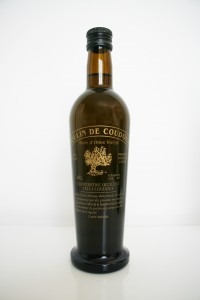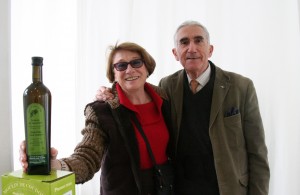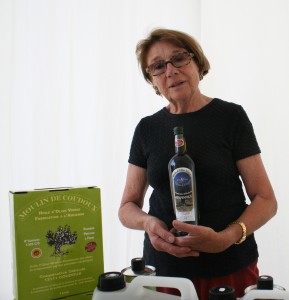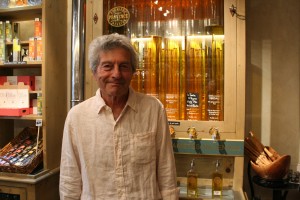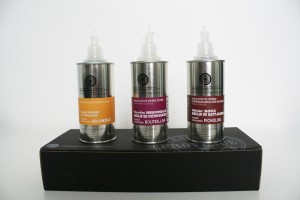Last June I blogged about the olive oil produced by Chantal de Lander-Gaubens, whom I met at the Boutique Ephémère located in the 15th arrondissement of Paris.
There is no need to repeat the information that I gave in the blog of June 13, 2012 about how her oil is produced, but I do want to talk about a product of hers that I didn’t get a chance to taste at that time. It is called fleur d’huile and is one of the most sublime olive oils that I have ever tasted. I was fortunate to learn that she was returning to the Boutique Ephémère from her olive orchard in southern France during the first weekend of February, so I contacted her to order a bottle.
Madame de Lander-Gaubens explained to me that the oil comes from olives that have not yet been pressed. They have gone through the grinding process, but as the olive paste is placed in the scourtins (fiber mats) and mounted in the hydraulic press, oil drips out before the pressing begins. This oil—fleur d’huile—is captured and bottled separately from the oil that is squeezed from the paste by the action of the press.
Back at the kitchen table Monique and I tasted the oil, first by pouring it directly into small spoons, and later by dripping it on slices of fresh baguette. It has a brilliant, clear olive-green color and its aroma is slightly sweet. It tastes fruity—with a flavor similar to Juicy Fruit gum—and it has a peppery aftertaste. A discovery for us, this fleur d’huile is ambrosial!
Madame de Lander-Gaubens’ husband Olivier was with her on that day and I took a picture of them together. It was a pleasure to meet them both!
Domaine de Vautubière
13111 Coudoux
France
Tel.: 04.42.52.12.23
Web site: www.huiledecoudoux.com
We participate in Wanderfood Wednesdays. Head over there to explore food from around the world!
Like our blog? Join us on Facebook!

